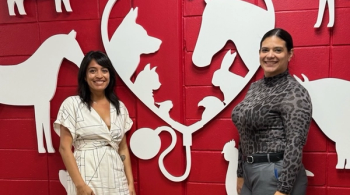
How to build a referral network: Nuts, bolts, and good manners (Supported by Nestlé Purina, Pfizer Animal Health, and the Veterinary Specialty Practice Alliance)
You've decided to expand the horizons of your practice, accept the mantle of the primary care veterinarian, and become part of a network of colleagues-responding to the health care needs of pets with the best care possible.
You're an independent soul, you trust your skills, and your clients are ... well ... your clients. But the bond you've built with them and their pets prevails. You've chosen the high road.
What's next? The decision has been made, but the network remains just an idea. What are the nuts, bolts, and good manners of building a referral network?
The American Animal Hospital Association (AAHA) recently completed a final draft of referral guidelines (See AAHA guide to smooth referrals). The 10-person task force focused almost entirely on communication issues meant to "bridge the referral communications gap" in establishing healthy referral networks (visit
Cheryl Waterhouse, DVM, a primary care veterinarian based in Fresno, Calif., and Kelly Diehl, DVM, MS, DACVIM, an internal medicine specialist at the Veterinary Referral Center of Colorado (VRCC) in Englewood, Colo., see communication at the center of the modern referral network practice. Both have been big believers in the referral network for years, and they're happy to see the idea has reached the mainstream of veterinary thought. Providing the best healthcare for pets is at the core of veterinary medicine, after all. And a strong referral network is an important piece of that care. But how does one go about stretching the boundaries of the individual practice to include a network of pet healthcare providers?
Build it and they will come
A habit of connecting
From the sidewalk outside the Waterhouse Animal Hospital, the horizon is already pretty broad. In the center of California's expansive Central Valley, Fresno's Dodger blue skies stretch all the way from here to there. In 1995 when Dr. Waterhouse moved to Fresno, she was already adept at stretching the edges of her practice as wide as possible.
"I was referring clients back when I practiced in Des Moines and Kansas City," she recalls. "My personal philosophy was then as it is today—offer clients and pets the highest level of medical care available. Sometimes that means referring to a specialist."
After setting up shop on Cham-plain Drive, it didn't take long for Dr. Waterhouse to reach out and extend her practice. Through networking with other veterinarians and colleagues in the Fresno area, Dr. Waterhouse introduced herself to area specialists. Over the years, Dr. Waterhouse and her newfound colleagues developed strong professional bonds and shared many positive client experiences. What made it work was getting rid of the thought that she was just in business for herself—and it opened up a door to better healthcare for her patients and clients.
"Specialists are an extension of your primary care practice," she says. "You shouldn't think of them as your competitors. You should think of them as an arm you use to reach out and grab the ultimate prize—a stronger relationship with the pet and the pet owner."
Dr. Diehl, a VRCC specialist since 1997, says clients know how much you care about their pet by the actions you take.
"I have had very few clients over the years that were upset at their primary care veterinarian because they were referred," she says. "Most clients see it as a demonstration of the primary care veterinarian's concern for their pet. Since the goal is to give the pet the best care possible, referral is just one more step to accomplishing that goal."
Dr. Waterhouse and Dr. Diehl say the nuts and bolts of building a successful referral network include knowing where and why you refer. However, any structure will crumble and fall if not maintained. They say close communication is the cohesive element that keeps a referral network strong. If you communicate effectively, there will never be a lapse in the higher level of care the pet and client deserve.
Step #1: Investigate
Choosing the right specialist isn't as easy as opening up the yellow pages and looking under the "right specialist" section. Not every specialist shares the same philosophy on teamwork and communication, so researching who will benefit your patients and clients most will take some digging.
Dr. Waterhouse says the first step to fostering a healthy referral program is to find out what specialists are available in your neighborhood.
"Refer to specialists in your area," she says. "They'll have more of a need to communicate directly. If you don't know where the specialists are around you, consult your colleagues and have faith in their judgment."
Dr. Waterhouse suggests smart shopping on behalf of your patients and clients. Find out which specialists other practitioners in the area are using. Look into the specialties offered and listen to what others say about client experiences there. Create a list. Making personal visits to referral practices that climb to the top of the list will offer first-hand information.
Dr. Diehl says attending continuing education courses is a good way to get to know a prospective referral specialist. She says talking with a specialist in person gives you something more than the often formal and cold conversations you might have on the phone.
"Continuing education seminars help you put a face to the name and a voice to the one you hear on the phone," she says. "Talking face-to-face and receiving those nonverbal messages can help the primary care veterinarian get a better sense of who we are."
Step #2: Keep the channels open
Referring a client is not the end of the process by any means. The primary care veterinarian is still the patient's keeper, and they along with the specialist both serve essential functions in a three-way conversation between the specialist and the client.
Dr. Diehl says she sends primary care veterinarians detailed letters outlining the course of treatment the pet received, a diagnostic plan, any test results she has, and interpretation of those results. She also makes phone calls to the referring veterinarian whenever possible, particularly if a patient is not doing well.
Dr. Waterhouse says she also makes an effort to keep the specialist in the loop after the patient comes back to her. If the dog is having problems on a medication or treatment plan a specialist prescribed, she calls and asks for their opinion about the situation.
Step #3: Maintain respect
When a client's visit to a specialist goes well and when it goes wrong, the primary care veterinarian is, by necessity, right in the middle. Dr. Diehl says sometimes the primary care veterinarian might take the heat for something the specialist did. But if the specialist is informed, she says they can help make things right again and keep the client confident that their primary care veterinarian and the specialist have theirs and their pet's best interests at heart.
"We (specialists) try to see if we can repair the relationship or get some constructive criticism," she says. "Although it can be uncomfortable, these sessions almost invariably turn out well. No one is perfect. We have off days and poor communication sometimes, but we can learn from those experiences if we know about them."
Positive client experiences may be thought of as commonplace and routine, Dr. Waterhouse says. However, she says specialists still appreciate hearing that your relationship is producing positive results. "I call and tell the specialist, 'The client was really appreciative and just loved you,' or, 'The dog's doing great.' And they love it. Hey, they're human too."
When to refer
You've evaluated the situation and it's clear that specialized care is needed to pull your patient through. Your expertise is vast and can carry them through almost anything, but you feel a different skill set or specialized equipment is needed to take care of the problem. But how do you know when to make the hand off? Dr. Diehl says referring early could mean catching something before it gets out of hand. The precaution can strengthen the client-primary care veterinarian bond because clients know you don't want to gamble with their pet's health.
"We can relieve some of the burden on the primary care veterinarian if we can see the patient early," she says. "That makes us a more effective team to manage the case."
Dr. Waterhouse also thinks communication with a specialist is instrumental even before the choice to refer has been made. She routinely calls specialists for advice in early stages of diagnosis and treatment.
"Specialists understand that the relationship we have with them is a partnership," she says. "If you've built a good foundation, there's an understanding that you're going to be there for each other. I've never had a specialist say, 'You need to pay me for this consult,' or 'No, I can't talk to you.'"
Dr. Diehl reminds primary care veterinarians and specialists not to lose focus on what's really important. "We all need to overcome challenges to communication and to try to remember the pet's health is the center of all of our concern."
When all is said and done, the tools for building a strong network are simple: some research to determine area specialties, good communication, willingness to ask questions, and attention—always—to your patient's healthcare needs and the best way to meet them.
STANDARD OF CARE IS THE LEGAL WATCHWORD
Talk to Charlotte Lacroix, DVM, JD, about the legal aspects of referral for primary care practitioners and her argument consistently returns to three imperatives that could just as easily be ethical, as legal:
- "It's about the standard of care, and money is never in the mix."
- "If the treatment is, in your opinion, beyond your expertise, refer."
- "You have a legal obligation to ensure that the patient receives treatment within the standard of care."
Dr. Lacroix, who is a veterinary attorney and owner of Veterinary Business Advisors, Inc., sums up the legal reality of referral in these stark terms: "You will be negligent if you take care of an animal beyond your expertise. If you have a bad outcome, malpractice could be the result."
But putting these principles into practice may not be so clear-cut. For example, knowing your limits, she says, is your responsibility, and your limits must be determined on a case-by-case basis. The law provides only a general map of the terrain.
"The law is not in the habit of saying these things must be done by specialists," she explains. "It doesn't micromanage. The test is whether this is reasonable.
"The standard of care changes every single day—it can't be written down, and it's what is being taught in veterinary school and in continuing education. The profession is continually improving, and the standard of care is continually getting tougher."
Along with limits, knowing the standard of care is also your responsibility. "A professional has a responsibility, legally and ethically, to keep pace," she says, although adding that the courts generally recognize different standards between specialists and primary care veterinarians.
Along with limits, knowing the standard of care is also your responsibility. "A professional has a responsibility, legally and ethically, to keep pace," she says, although adding that the courts generally recognize different standards between specialists and primary care veterinarians.
Dr. Lacroix helps practitioners look at these legal questions from the perspective of laymen. If specialists are in proximity to the primary care practice and the client, making a referral for a case beyond your expertise is a reasonable expectation.
"We don't always appreciate what society expects of professionals," she says. "They expect the same ethical standards of any profession. That means the interests of the clients and patients come first."
Newsletter
From exam room tips to practice management insights, get trusted veterinary news delivered straight to your inbox—subscribe to dvm360.






